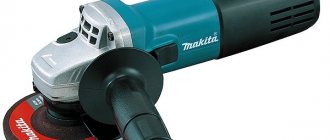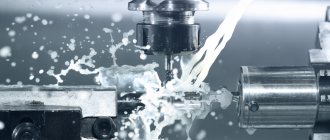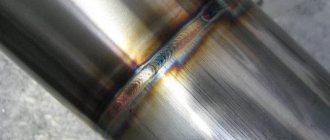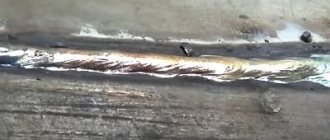“Stainless Steel Processing” is an article about the basic technology of stainless steel processing. Grinding and polishing of stainless steel welds to a mirror shine, profile and round pipes, how and with what paste, with video
Subscribe to the newsletter so you don't miss new articles and drawings:
This article is from a series of articles devoted to the production of railings and fencing as a business. In the future, I will write articles with videos on making exclusive stainless steel railings. In the next video I will make a fence from a profile pipe.
If you are interested in opening the production of fences and railings. I advise you to read the article “What kind of production to open”. The article describes marketing principles that help promote such a business.
Below are two videos showing the processing of stainless steel. Polishing and grinding of welded seams of round and profile pipes, in the first video how to bring it to a mirror shine. In the second, giving a matte surface.
In this way you can polish and grind not only stainless steel, but also any metal. The only difference is in the hardness of the metal; you will spend more time and consumables on iron than on stainless steel, and you may not even notice the difference, only on large volumes. Brass and copper can be polished without grinding, but it is still better to use sandpaper, and cast iron generally does not lend itself well to polishing. Also, other metals are susceptible to exposure to the external environment, iron rusts, brass and copper darken. So other metals need to be chromed or varnished.
How a polished stainless steel pipe is made, scope of application, dimensions
Popular in industrial and domestic construction, polished stainless steel pipes are distinguished by high quality, wear resistance, reliability, long service life and aesthetic appeal. This material will discuss materials and standards for the manufacture of polished stainless steel pipes, as well as areas of its active application.
Production technologies
According to the production technology, a polished stainless steel pipe is practically no different from ordinary pipes. The only difference between them is the finishing treatment of the product after leaving the assembly line.
Thus, two types of pipe products are distinguished:
Welding method
The production of this type of product is carried out in accordance with the 1983 standard, where they are also called electric welded. However, although electricity is indeed used in this case, modern technologies are not exactly electric welding.
Among the methods for producing welded pipes are the following:
- laser welding;
- use of high-frequency induction currents for welding;
- welding in inert gas using tungsten electrodes. They create an electric arc that allows the metal to be heated to the melting temperature to join the edges of the workpiece;
- electron beam welding technology involves working in vacuum conditions, so it can be called the most exotic.
In general, the technological process consists of twisting the workpiece into a tube of the required diameter, welding it along the seam, further calibrating it in rollers and checking for tightness of the connection. Grinding of the stainless pipe is done at the very end.
Seamless production of stainless steel polished pipes
At the initial stage, using pressing or casting, a hollow round workpiece is produced, which, after careful processing and calibration in rollers, will become a finished pipe.
Based on the processing temperature, such pipes are divided into the following categories:
- cold-worked;
- heat deformed;
- hot-deformed.
Please note that according to GOST, the production technology of the last two types of pipes involves heat treatment. First, the pipes are heated, then allowed to cool to remove internal metal stresses. In this case, any violation of the technology will lead to deterioration in the quality of the pipe and loss of its strength.
Surface treatment methods
The external surface treatment of stainless steel pipes will be the same regardless of their production technology.
In general, there are only two methods for performing such processing: abrasive and electrochemical.
Electrochemical processing
This process is carried out in a solution of concentrated acid. A round electrode is lowered into the bath along with the pipe and placed either inside it or around it - it all depends on whether the internal or external surface is to be processed. After this, a high current is supplied to the entire structure.
Surface grinding occurs due to the fact that the particles located closest to it first begin to move from the anode to the cathode.
Use of abrasives
Rough processing of pipes with abrasive can be carried out during the pipe production process. In this way, the cheapest polished stainless steel pipes are made.
But to get a polished stainless steel pipe, it is successively processed with several types of abrasives, each time reducing the grain size. Finally, the product is polished with felt sanding belts.
Electrochemical processing
To treat a pipe or any other stainless steel product using the electrochemical method, it is immersed in a solution of concentrated acid. If it is necessary to polish the outside of the product, the pipe is surrounded by a round electrode. If the inside is the electrode, the electrode is placed inside a stainless pipe. Then current is applied. Irregularities in the metal surface disappear due to the fact that the closest steel particles rush from the anode to the cathode.
But in most cases, polishing a stainless pipe is an insignificant stage in the production of pipe products. For example, AISI 430 steel, which has excellent properties of strength, durability and resistance to corrosion, is polished only for the sake of aesthetic beauty. Polished pipe is most often used in the production of furniture and decorative elements. In industry, the mirror surface of a material plays almost no role.
Standard sizes
The standards used for the manufacture of polished stainless steel pipes are similar to other products made from corrosion-resistant steels:
- According to GOST 9940-81, hot-deformed seamless pipes are produced with a cross-section of 57-325 mm and a wall thickness in the range of 3.5-32 mm.
- Cold- and heat-deformed seamless pipes in accordance with GOST 9941-81 can have a diameter in the range of 5-273 mm, and the wall thickness ranges from 0.2-22 mm.
- According to GOST 11068-81, the diameter of welded pipes can reach 8-102 mm with a wall thickness of 0.8-4 mm.
It is worth noting that the greatest demand is still for thin-walled pipes, which are characterized by wear resistance, reliability and attractive appearance. Most of these polished stainless steel pipes are produced by welding.
What is pipe polishing
The final stage in the manufacture of rolled pipes, which consists of melting the surface layer and processing it in various ways in order to eliminate roughness, unevenness and microdamage, is called pipe polishing.
Features, types of polishing operations
Regardless of the method of producing rolled products, metallurgical enterprises use two methods of polishing pipe products:
- electrochemical;
- abrasive.
Both the external and internal sides of the product are subject to processing.
When using an electrochemical polishing process, pipes are lowered into a special bath with a concentrated acid-containing mixture. Then an electrode is placed in the solution and fixed either in the hole of the tubular product or on its outside, after which a high current is applied. Due to the active movement of anodic-cathode particles, the metal surface is cleaned of irregularities formed during production cycles.
Polishing a pipe using an abrasive method is cheaper and does not require special skills from craftsmen. Rolled pipes are processed with abrasives of various fractions, which helps to obtain a mirror-like shine of the finished product. At the final production stage, felt rollers, elastic tape-like devices and suspensions of metal oxides are used in turn.
There is a known method of liquid abrasive polishing of pipe products. In this case, a liquid is used as a basis, which wets the surface of the pipe and the grinding parts. The parameters of the finished product processed in this way do not differ from the parameters when using abrasives during dry polishing.
Advantages of polished rolled metal:
- high resistance to corrosion;
- pleasant appearance;
- durability;
- easy maintenance;
- does not change functions during operation;
- distinctive resistance to aggressive environments and temperature changes.
Application of polished tubular products
Ground rolled pipe has gained wide popularity due to its chemical stability under changing conditions: the processed metal does not tend to emit oxides, odors, or harmful fumes. Therefore, polished pipe profiles are used in the medical, food, and chemical production fields.
Design activities, production of furniture for commercial and domestic premises, production of sanitary equipment cannot do without rolled pipes with a mirror shine. Heated towel rails, bathroom equipment, fountain structures, office chairs, bar counters, railings, stairs - a list of the most commonly used products using polished pipes.
Polished pipe parts are used in shipbuilding and mechanical engineering. The resistance of the polished material to corrosion allows the pipes to be used in environments with high humidity and acidity.
The attractive appearance of rolled pipes, which is preserved during the operation of the product with constant temperature changes, makes it possible to produce decorative devices for the street from polished parts: design of personal plots, urban home areas.
Areas of use
Polished stainless steel pipes are purchased mainly because of their external beauty, since they are often used for decorative purposes.
Very often such products are used in the following cases:
- Furniture manufacturing. For example, frames for chairs and beds, parts for mobile furniture, various racks and supports. Such decorative elements can withstand many years of use without loss of shine and beauty, which, for example, chrome-plated pipes are not capable of.
Grinding and polishing stainless steel
The best qualities of stainless steel are widely used in the construction industry, industrial production and everyday life. These are strength, resistance to corrosive changes, as well as visual appeal. Ground and polished products have these properties. provides services for grinding and polishing stainless steel using modern methods. We work with alloys 12Х18Х10Т, AISI 304, AISI 316, AISI 316L. We carry out internal and external polishing of pipes with a diameter of 12 to 200 mm.
Abrasive method
In this case, the polished stainless steel is subjected to processing of the outer or inner surface with abrasive substances. Different grain fractions are used. Using the abrasive method, an absolutely smooth surface is obtained, often even mirror-like. Although processing with coarse abrasive can be used at the manufacturing stage. This is how the cheapest stainless steel profile pipes are made. In other cases, polishing a stainless pipe begins with grinding with a coarse-grained abrasive, then the grain diameter is reduced and the process moves on to the finest processing. It involves felt rollers.
This polishing method is called cylindrical grinding and is most often used for pipes - processing internal and external surfaces. Stainless steel products are subjected to belt grinding, which uses elastic belts, and abrasive suspensions based on metal oxides are used as an additional means. Typically, the abrasive grain diameter in this case does not exceed 5 microns. It is also worth adding that abrasive polishing can be dry or wet. In the second case, the particles are carried by water.
Stainless steel grinding - eliminating material defects
When processing any metal, it is impossible to avoid the appearance of scratches, burrs, and small cracks. To rid the surface of these flaws, the product is first ground and then polished.
Grinding stainless steel involves uniform removal of the thinnest top layers. The complexity of the task is explained by the strength of the material and the necessary accuracy of the process. Therefore, to achieve an ideal result when grinding stainless steel, the company carefully selects modern equipment.
The technology for grinding stainless steel is based on the impact on it using abrasive elements. Depending on the purpose, natural or artificially produced compounds are used. Grinding can be either simple or extremely complex, which is used in the manufacture of non-standard parts.
The finer the grain of the abrasive belt, the finer the processing will be. A high degree of adhesion is achieved when polishing stainless steel with abrasives with a linen backing.
Based on the selected temperature regime, hot and cold grinding are distinguished. According to the volume of work done - one-sided and two-sided.
Grinding of stainless steel sheets and pipes is necessary to obtain high-quality materials for the following industries:
- construction industry;
- interior and exterior decoration - this requires polishing a stainless steel pipe;
- production of advertising and information stands, banners and other structures;
- production of drainage systems and windows;
- production of equipment for the food and chemical industries.
In addition, grinding stainless steel sheets makes it possible to create a durable and visually attractive base for the manufacture of household items.
Polishing stainless steel - technology features
The process of polishing a stainless steel sheet is to create a perfectly flat and smooth surface. Based on the result, there are two types most in demand today:
- matte polishing of stainless steel - on this basis traces of use are almost invisible;
- polishing stainless steel to a mirror finish is a more labor-intensive technology that requires the use of polishing compounds.
Currently, enterprises polish metal in several ways. Based on the characteristics of the material and the assigned tasks, the following can be selected:
- Mechanical polishing - using abrasive particles and polishing pastes.
- Chemical. The products are kept in a special solution.
- Electrochemical. A current is passed through the solution, which allows you to achieve ideal results.
- Plasma polishing of stainless steel. You can order such a service at enterprises equipped with appropriate equipment. The method is highly environmentally friendly.
Choosing an angle grinder or grinder for grinding and polishing stainless steel
I have extensive experience using grinders for grinding (more than 12 years) and the best of them is Metabo. In terms of price/quality ratio it is natural.
Article
article about grinders
An article where I write in detail about grinders HERE
Characteristics of the required grinder
- Power from 1400 W
- Speed adjustment 2500-11000 rpm
- The size of the grinder for 125 mm discs is small, otherwise your hands will get tired quickly
The grinder is better than the metabo, which is FEIN, but the cost with the same characteristics is three times more.
Grinder Metabo WEV 15-125 Quick
Today we use this model of Metabo angle grinders in our production. In the video I’m using an angle grinder from this company.
The average cost of such an angle grinder is around 8,500 rubles. If you take it for home, then for life, if for production, then you won’t find a more economical option.
You can order an angle grinder in the store by following the link HERE
Consumables
Sutures are removed using a KLT circle with a diameter of 125 mm. Grit size P-80 - P-120. The video uses the Luga-Abrasive Circle. The best 3M, but expensive.
After CRT, it is necessary to smooth out unevenness and rough risks after CLT. They are removed with a Velcro sanding wheel, Grain R-80. Risks after the P-80 circle are removed with the same circle using P-320 grain.
I advise you to use circles from Mirka; using cheap ones will be more expensive.
Polishing . When grinding of welds with P-320 grain is completed, polishing of the pipe begins to a mirror shine, using felt + paste. You can goy, but it is harmful.
Wipe with a cloth
Stainless steel grinding in Moscow: quality and prices
Polishing and grinding of stainless steel are among the work in which . Advantages of contacting us:
- polishing and grinding of any type of stainless steel, as well as other metals;
- highly qualified and extensive experience of craftsmen;
- use of the latest generation CNC equipment;
- execution of the order in a short time.
The use of modern technology can significantly reduce the cost of the process. Therefore, the prices are very affordable.
Methods for polishing stainless steel
Stainless steel polishing can be done at home. In this case, several processing methods are used. Common methods include:
- mechanical;
- electrochemical;
- electrolyte-plasma.
Mechanical restoration
Polishing of stainless steel is carried out using a material represented by grains of abrasive material. When processing, a circle, disk, roller or tape is used. Various pastes, solutions and suspensions for polishing act as abrasives. The material may contain substances that, in combination with abrasive grains, remove irregularities on metal surfaces. This type of processing is called mechanical.
As a result of mechanical impacts on the metal surface, grooves and stripes with roughness up to class 7 are formed. In this case, additional refinement of stainless steel to class 10 by grinding is necessary.
Refinement of stainless steel can be done at home without the use of special devices and tools. This type of polishing is common in private workshops and garages. In industrial enterprises, the following types of tools are used:
- manual devices with electric and pneumatic drive;
- polishing and grinding machines;
- drum and vibration units;
- installations for processing using magnetic abrasive.
The following abrasive materials are used for fine grinding:
- liquid polish;
- pasta;
- suspension.
They contain mineral oils, paraffin and stearin additives as a base; they must be removed after processing with solvents.
Electrochemical method
Chemical polishing is the process of removing roughness using the ordered movement of charged particles from one electrode to another. The method uses installations with baths filled with an electrolyte solution. One of the electrodes is connected to the negative pole of the power source. The immersed stainless metal workpiece is connected to the positive terminal of the power source.
When direct current is applied, charged ions begin to form on the metal surface, which then flow to the cathode. When stainless steel particles are released, the microprotrusions are smoothed out. During processing, the operator can set the depth of metal removal by adjusting the constant current value, as well as the process time.
The method allows you to polish parts with complex geometric surfaces. Uneven areas are removed from difficult to access areas. The electrolyte has a temperature of up to 90°C, a current density of 0.5 A/cm2, and contains inorganic acids: phosphoric acid and sulfuric acid.
Electrolytic plasma polishing
The method is based on the formation of a jacket on top of the part, which is a vapor-gas plasma. This allows you to remove irregularities from the metal surface. Apparatuses for polishing stainless steel at home operate on an alternating current network at a voltage of 400 V and an electrolyte solution temperature of 90°C. The rate of metal layer removal is up to 3 microns per minute.
The advantages of this method include:
- use of safe substances;
- minimum costs.
Metal polishing
With the help of grinding and subsequent polishing, metal surfaces acquire visual attractiveness, resistance to corrosion, and increased sliding ability of mechanical parts. Metal polishing is widely used not only in industrial production and instrument making, but also a quite popular service in everyday life.
Polishing from 2000 rub. m/sq.
The LAZERMETAL company has a wide arsenal of modern high-tech equipment - processing machines that perform grinding and polishing operations. These include internal grinding, cylindrical grinding and surface grinding work with increased precision.
Finishing of metal surfaces is the final production process. The thinnest layer of material is removed under the influence of abrasive substances and the product acquires a completely finished appearance.
In mechanical engineering, grinding of parts is carried out both outside and inside products, achieving accuracy classes 2 and 3 and up to 8-10 cleanliness classes (for example, in the production of ball bearings).
Our company uses stainless steel alloys AISI-316 for polishing; AISI-316L; AISI-304; 12X16X10T. We also carry out orders for finishing of pipes with a diameter of up to 200 mm.
Polishing stainless steel
During metal processing, burrs, scratches, and cracks inevitably appear. Such defects can be eliminated by preliminary grinding with special fillers and final polishing.
By grinding we mean uniform removal across the entire width or perimeter of the surface of a layer with a thickness of 0.2-0.5 micrometers. During polishing, this thickness is calculated in thousandths of microns, which is especially important in high-precision instrument making.
Stainless steel polishing technology involves exposing the metal to abrasive materials with a natural or artificial composition. To achieve a mirror-like surface shine, high technologies are also used in the mechanisms of processing equipment.
At the first stages of processing, abrasive belts with coarser grains are used, then the finest abrasives are used. Temperature plays an important role in polishing; a distinction is made between cold and hot polishing.
Grinding and polishing of parts is used in industries such as:
production of equipment for the food and chemical industries;
interior and exterior decoration;
Polishing technologies
The purpose of grinding and polishing is to achieve a perfectly smooth surface on a metal product. Their results differ in two types:
Matte surfaces with different levels of reflection without traces of processing.
Perfectly mirror surface.
In another case, this is the most labor-intensive technology using special abrasive compounds at the nanolevel.
Based on the assigned tasks for the purpose of the polished surfaces, one of the following processing technologies is selected:
Mechanical. Polishing pastes and abrasive belts are used.
Chemical. Surfaces are exposed to special solutions.
Electrochemical. An electrical charge is passed through chemical solutions. In this case, you get an ideal result.
Plasma and laser. Special high-tech equipment is used in industrial conditions. This method of metal processing is characterized by a highly environmentally friendly process.
Laser and plasma polishing is especially in demand in instrument making and in the decoration of exterior and interior elements. The chemical and electrochemical method is most applicable in the chemical and food industries. Mechanical polishing and stainless steel polishing services are quite in demand in everyday life today.
Polishes
Grinding of stainless steel is carried out using hand tools with an electric drive. The following are used as additional accessories:
- a circle of felt or felt, a napkin, and also a disk;
- roller;
- abrasive sheet, disc with an abrasive base;
- non-woven materials;
- polishing tapes.
The tools are:
- orbital sanders;
- grinders with a set of attachments;
- belt type machines;
- tape cutter for direct processing;
- portable sanders;
- tape-type files with the ability to rotate the attachments.
Stainless steel polishing products
Metal polishing service in Moscow from LAZERMETAL
Grinding and polishing of metal elements of various products is included in the range of works in which LAZERMETAL craftsmen specialize. The advantages of contacting our specialists are as follows:
- high qualifications and many years of experience in this type of activity;
- availability of high-tech CNC equipment and high-quality branded materials for processing;
- possibility of polishing all types of metals;
- orders are carried out with a quality guarantee and in the shortest possible time.
The use of modern equipment allows us to significantly reduce the costs of the production process, and therefore the final cost of orders. Our price for polishing stainless steel is significantly lower than in similar organizations. When submitting an application for our polishing services in Moscow, the consultant will explain all the details of placing an order. High-quality metal polishing is our job. Trust the professionals!
Grinding and satining (matting) the seam on a profile pipe
Consumables
The process of processing such as satin-finishing is not much different from processing under a mirror.
The sequence of using consumables begins in the same way as in the previous example. Only instead of felt we use a satin finish.
Sanding roller . After the Velcro sanding wheel with P-320 grit, a sanding roller is used. It is attached to a low-speed angle grinder using an adapter.
After the sanding roller, the surface is finished with Scotch Brite. We use
You can also refine the sanded surface with a sanding sponge. And a matte surface can be achieved with the same sponge after polishing the metal.











